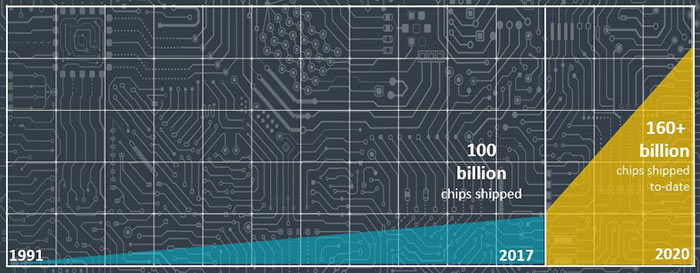On Sunday it was the 35th anniversary of the powering up of the first ARM processor. From its unlikely origins the popular RISC processor design has grown to dominate smartphone / tablet computing, and is making bold moves into servers, portable PCs, Mac computers, and Google computers. Figures show that Arm's 1000+ silicon partners have shipped over 160 billion ARM-based chips since the early 90s, with the current rate of shipments exceeding 6 billion per quarter.

'Hello World, I am ARM'
Principal designer behind the BBC Micro and the ARM microprocessor, Prof Steve Furber recalled the arrival of the first ARM processor in a Centre for Computing History blog post.
"At 1pm on April 26th 1985, the first ARM microprocessors arrived back from the manufacturer - VTI. They were put straight into the development system which was fired up with a tweak or two and, at 3pm, the screen displayed: 'Hello World, I am ARM'."
The original ARM1 was fabricated on VLSI's 3μm lithography process and contained just 24,800 transistors. WikiChip notes that it had a few major bottlenecks such as lack of hardware multiplication support, made worse by not supporting coprocessors. It is worth mentioning that Steve Furber's most recent / current project is the "world's largest supercomputer brain," dubbed SpiNNaker.

You might be irked by the use of both ARM and Arm above but I've attempted to use both terms correctly; the capitalised version is the original processor and architecture, the mixed case one refers to the company - in its post-Softbank era. Furthermore, ARM changed its meaning twice; originally it was an abbreviation of Acorn RISC Machine, but the name was later changed to Advanced RISC Machine.
While we are down memory lane, other major important computing events of 1985, as noted by the Computing History organisation, were: the Commodore Amiga launch, Microsoft's Windows launched, the Intel 386 iCPU was introduced, NeXT Computers was founded, and the Cray X-MP Supercomputer began operation.













